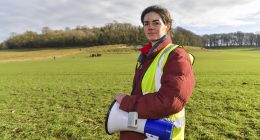When citizen science in school labs ended up in a particle accelerator, the results advanced our understanding of how crystals form – with a positive impact on the future of medicine, materials science and more
Gry Christensen was a 15-year-old year 11 student when she took part in a “citizen science” project to understand how the different crystals in mussel shells form. But unlike most school experiments, the samples that she and her 1,000 fellow secondary school pupils prepared were then blasted by scientists in a particle accelerator using X-rays 10bn times brighter than the sun.
“It was a bit of an eye opener,” Christensen says of the study, called Project M, involving students from 110 schools. They prepared different samples of calcium carbonate (the main component of mussel shells) that scientists then examined at the UK’s national synchrotron (a type of circular particle accelerator), the Diamond Light Source in Oxfordshire. The aim was to help scientists better understand how to form different types of crystal structures from the same chemical. “I was more interested in chemistry afterwards,” says Christensen, who went on to study agricultural science at Gråsten Landbrugsskole in Denmark. “The chemistry really helped me to have an insight into the natural world.”




